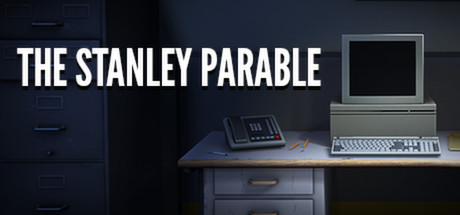“The Stanley Parable” makes players question who is really in control

The outcome of “The Stanley Parable” changes depending on the player’s decisions.
November 6, 2021
Choice-based games have become quite common in the past several years. Such games allow different outcomes depending on the choices the player makes.
However, one of these games stands out from the others: “The Stanley Parable.” Created by Davey Wreden and William Pugh and published by Galactic Cafe, this game takes an interesting look at the concept of free will and personal freedom.
In this game, you play as an office worker named Stanley. Stanley has worked for years inputting commands that are sent to his computer, but one day, no commands are sent. His coworkers have all gone missing.
The narrator, voiced by Kevin Brighting, points out each choice that Stanley is supposed to make. The player then has two choices: obey the narrator or defy him.
For example, one of the first rooms you come to is an empty rooms with two doors. The narrator dictates, “When Stanley came to a set of two open doors, he entered the door on his left.”
The player then has makes a decision to either follow along with the narrator’s story or disregard his directions. Based on the choices made as the player continues, the game can come to a total of 19 different endings.
Every single choice is narrated. This brings up an interesting debate. Who is really in control of the game? Is it the player or the narrator?
Sure, the participant has the option to disobey the narrator, but each decision thereafter is also commentated on. Which is more important: the decision or its outcome?
Content beyond this point in the article will contain spoilers.
The central ending of the game concludes with Stanley shutting down the Mind Control Facility, which was supposedly used to brainwash all of the company’s workers. This is called the Freedom Ending.
However, it’s interesting to note that you achieve this ending by following the narrator’s directions for the entire run. The “freedom” ending is the route where the player is the least in control.
If the player chooses to activate the mind control facility, the narrator makes an intriguing move.
He says, “If you want to throw my story off track, you’re going to have to do much better than that. I’m afraid you don’t have nearly the power you think you do; for example, and I believe you’ll find this pertinent: Stanley suddenly realized that he had just initiated the network’s emergency detonation system.”
The narrator still controls the outcome even if the player make the defiant choice. So, is it the player’s choice that determines the state of their independence or the consequences?
Essentially, the concept of the player’s choice is simply illusionary.
Aside from its interesting take on the concept of player choice, “The Stanley Parable” features delightful and witty humor. The narrator throws a bounty of sarcastic quips at the player based on the choices they make.
For example, the player has the option to walk into a broom closet on their way to the boss’s office. This closet has no real significance in the game, but standing inside provides some very entertaining dialogue.
The narrator remarks, “You do realize there’s no choice or anything in here right? If I said, ‘Stanley walked past the broom closet’ at least you would have had a reason for exploring it to find out.”
The game is very self-aware. The narrator, depending on the ending, will often make it known that he is conscious of the fact that he and Stanley are both in a game.
Overall, “The Stanley Parable” has no shortage of thought-provoking content, and you’re sure to find more each time you watch or play.














